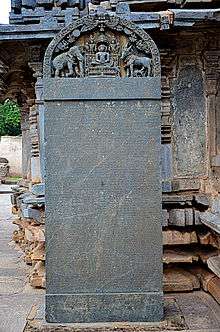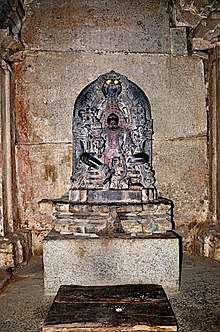Akkana Basadi
Akkana Basadi (lit, temple of the "elder sister", basadi is also pronounced basti) is a Jain temple built in 1181 A.D., during the rule of Hoysala empire King Veera Ballala II. The basadi was constructed by the devout Jain lady Achiyakka (also called Achala Devi), wife of Chandramouli, a Brahmin minister in the court of the Hoysala king. The main deity of the temple is the twenty-third Jain Tirthankar Parshwanath.[1][2][3] The temple is protected as a monument of national importance by the Archaeological Survey of India.[4]
| Akkana Basadi | |
|---|---|
 Akkana Basadi at Shravanabelagola town | |
| Religion | |
| Affiliation | Jainism |
| Deity | Parshwanath |
| Festival | Mahavir Jayanti |
| Location | |
| Location | Shravanabelagola, Hassan District, Karnataka |
| Geographic coordinates | 12°51′31.84″N 76°29′20.61″E |
| Architecture | |
| Creator | Achala Devi |
| Date established | 1181 A.D. |
Temple plan

According to art historian Adam Hardy, the basadi is a simple single shrine with superstructure (ekakuta vimana[5]) construction with a closed hall (mantapa). The material used is Soap stone.[6] The sanctum (garbhagriha) that houses the standing image of Tirthankara Parshwanatha (under a seven headed snake canopy) connects to the hall via an antechamber (vestibule or sukanasi). From the outside, the entrance to the hall is through a porch whose awning is supported by lathe turned half pillars. According to art historians Percy Brown and Gerard Foekema, all these features are commonly found in Hoysala temples.[7][8] According to historian Kamath, the use of Soap stone as basic building material was a technique the Hoysalas adopted from the predecessors, the Western Chalukyas.[9] The temple which faces east is enclosed with in a bounding wall (prakara), while the entrance is from the south. Typical of a Jain basadi, the outer walls of the temple are plain, giving it an austere outlook. The temple stands on a base (adhisthana) that comprises five moldings.[2]
The tower over the shrine (shikhara) is plain. However, on a projection on the east side is a panel sculpture in relief that depicts a saint with his attendants (yaksha, the benevolent spirits) on either side and a Kirtimukha (imaginary beast) over his head. This is a work of merit. The tower comprises three tiers, each ascending tier diminishing in height. Above the third tier is a dome like structure. This is the largest sculptural piece in the temple with a ground surface area of about 2x2 meters (amalaka, "helmet" like structure). The shape of the dome usually follows that of the shrine (square or star shape).[10] The vestibule also has a short tower which looks like an extension of the main tower over the shrine. Gerard Foekema calls it the "nose" of the main tower.[11] The vestibule contains two free sculptures of the yakshas, Dharnendra and Padmavati. The door lintel and jamb of vestibule and the sanctum are decorative and have perforated screens on either side. The hall ceiling is supported by four centrally placed large lathe turned, bell shaped and polished pillars that divide the ceiling into nine "bays". The bay ceilings are rich in relief.[2][11]
Gallery
_at_Shravanabelagola.jpg) Ornate closed mantapa whose ceiling is supported by lathe turned bell shaped pillars
Ornate closed mantapa whose ceiling is supported by lathe turned bell shaped pillars Decorative "bay" ceiling in Akkana Basadi
Decorative "bay" ceiling in Akkana Basadi- Decorative bay ceiling
 Old Kannada grant inscription (1182 A.D.) of King Veera Ballala II, at the request of Achiyakka, wife of minister Chandramouli
Old Kannada grant inscription (1182 A.D.) of King Veera Ballala II, at the request of Achiyakka, wife of minister Chandramouli Porch entrance to Akkana Basad with the awning supported by half pillars with old Kannada inscription on the side.
Porch entrance to Akkana Basad with the awning supported by half pillars with old Kannada inscription on the side. 5 feet tall idol of the 23rd Tirthankar Parshwanath standing under a seven headed snake
5 feet tall idol of the 23rd Tirthankar Parshwanath standing under a seven headed snake Intricate relief on pillar at Akkana Basadi
Intricate relief on pillar at Akkana Basadi Sculpture of Yaksha Dharanendra
Sculpture of Yaksha Dharanendra Sculpture of Yakshi Padmavati
Sculpture of Yakshi Padmavati
See also
| Wikimedia Commons has media related to Akkana Basadi. |
- Jain Basadi complex, Halebidu
- Shravanabelagola
- Jainism in Karnataka
Notes
- Jain and Jain (1953), p.37
- "Akkana Basti". Archaeological Survey of India, Bengaluru Circle. ASI Bengaluru Circle. Retrieved 3 April 2013.
- B.L. Rice (1889), p.57 (Chapter:Introduction)
- "Alphabetical List of Monuments - Karnataka -Bangalore, Bangalore Circle, Karnataka". Archaeological Survey of India, Government of India. Indira Gandhi National Center for the Arts. Retrieved 5 April 2013.
- Foekema (1996), p.25
- Hardy (1996), p.343
- Brown in Kamath (2001), pp.134-135
- Foekema (1996), pp.21-25
- Kamath (2001), p.136
- Foekema (1996), p.27
- Foekema (1996), p.22
References
- Gerard Foekema, A Complete Guide to Hoysala Temples, Abhinav, 1996 ISBN 81-7017-345-0
- Kamath, Suryanath U. (2001) [1980]. A concise history of Karnataka: from pre-historic times to the present. Bangalore: Jupiter books. LCCN 80905179. OCLC 7796041.
- Rice, Benjamin Lewis (1889). Epigraphia Carnatica: Rev. ed, Volume 2-Inscriptions at Shravana Belagola. Bangalore: Government of Mysore Central Press.
- Jain and Jain, Surendranath and Sarojini (1953). "Bastis in Shravanabelagola Village". Bahubali of Jainbadari (Shravanabelagola) and other Jain shrines of the Deccan. Shravanabelagola: SDJMI Managing Committee.
- Adam Hardy, Indian Temple Architecture: Form and Transformation : the Karṇāṭa Drāviḍa Tradition, 7th to 13th Centuries, Abhinav, 1995 ISBN 81-7017-312-4.
- "Alphabetical List of Monuments - Karnataka -Bangalore, Bangalore Circle, Karnataka". Archaeological Survey of India, Government of India. Indira Gandhi National Center for the Arts. Retrieved 12 July 2012.
- "Akkana Basti". Archaeological Survey of India, Bengaluru Circle. ASI Bengaluru Circle. Retrieved 3 April 2013.